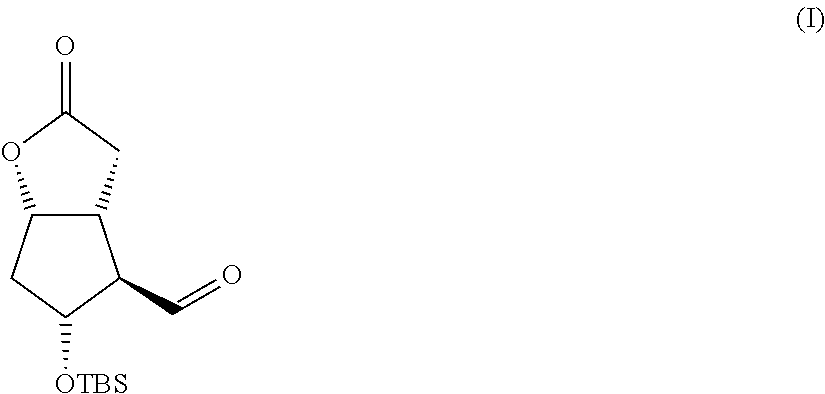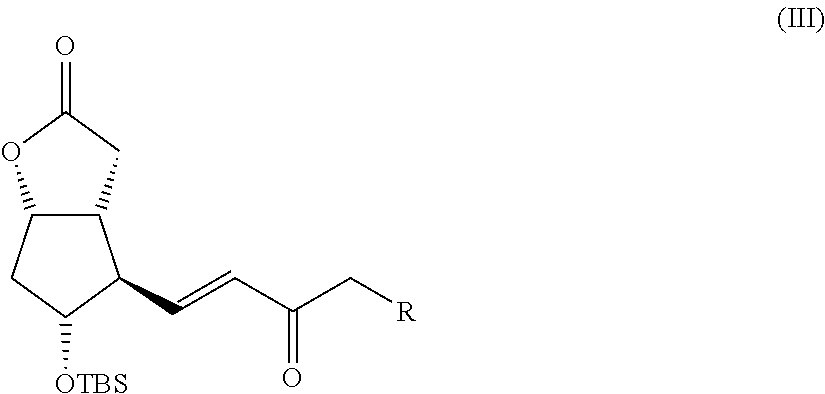Process for the preparation of prostaglandin derivatives
a technology of prostaglandin and derivatives, applied in the preparation of organic compounds, group 4/14 element organic compounds, organic chemistry, etc., can solve the problems of complex nmr spectra and chromatographic profiles, and end products with poor yields
- Summary
- Abstract
- Description
- Claims
- Application Information
AI Technical Summary
Benefits of technology
Problems solved by technology
Method used
Image
Examples
example 1
Preparation of the Key Intermediate of General Formula (Iv) where R is a Benzyl Residue
Preparation of the Compound III (Scheme I)
[0070]A solution of dimethyl-(2-oxo-4-phenylbutyl)phosphonate (9.72 g, 0.038 moles, 1.08 eq) in tetrahydrofuran (340 mL) is slowly added to a suspension of NaH (60% in weight in mineral oil, 1.46 g, 0.036 moles, 1.04 eq) in tetrahydrofuran (200 mL) cooled to 0° C., in a static argon atmosphere. After the additions, the previously milky solution becomes clear, the ice and water bath is removed, and the solution is left under vigorous stirring at room temperature for one hour during which the formation of a white precipitate is observed. After one hour the solution is brought back to 0° C. and Corey I aldehyde is added (10 g, 0.035 moles) dissolved in tetrahydrofuran (75 mL), after which the ice bath is removed. After 90 minutes the reaction is complete and to quench it the following are added: acetic acid (2 mL), a saturated solution of ammonium chloride (2...
example 2
Preparation of the Key Intermediate of General Formula (Iv) where R is a 3-trifluoromethylphenoxy residue
Preparation of the Compound III (Scheme Iv)
[0072]A solution of [2-oxo-3-(3-trifluoromethyl-phenoxy)-propyl]-phosphonic acid dimethyl ester (489 mg, 1.5 mmoles, 1.2 eq) in tetrahydrofuran (10 mL) is slowly added to a suspension of NaH (60% in weight in mineral oil, 55 mg, 1.37 mmoles, 1.1 eq) in tetrahydrofuran (6 mL) cooled to 0° C., in a static argon atmosphere. After the additions, the previously milky solution becomes clear, the ice and water bath is removed and the solution is left under vigorous stirring at room temperature for one hour during which the formation of a white precipitate is observed. After one hour the solution is brought back to 0° C. and the Corey I aldehyde (355 mg, 1.25 mmoles) is added dissolved in tetrahydrofuran (3 mL); after which the ice bath is removed. After 90 minutes the reaction is complete and to quench it, the following are added: acetic acid (...
example 3
Preparation of the Bimatoprost (Scheme II)
Preparation of the Compound V
[0074]Imidazole (720 mg, 10.6 mmoles, 2.5 eq) and TBS-Cl (702 mg, 4.67, 1.1 eq) are added at room temperature in the above order to a solution of alcohol IV (1.76 g, 4.24 mmoles) in dichloromethane (35 mL) and the formation of a white precipitate is immediately noted; the reaction proceeds under stirring at room temperature and is complete after 18 hours; to quench it, a saturated solution of sodium bicarbonate (30 mL) is added, it is diluted with dichloromethane (25 mL), the phases are separated, the aqueous phase is extracted with dichloromethane, the re-combined organic phases are dried on magnesium sulphate and filtered, and lastly the solvent is removed at reduced pressure. The product is purified by means of column chromatography (hexane-AcOEt 9:1 v / v). The pure product is obtained as a white solid with a yield of 95%.
Preparation of the Compound VI
[0075]DIBAL-H (1 M in hexane, 4.12 ml, 4.12 mmoles, 1.15 eq)...
PUM
| Property | Measurement | Unit |
|---|---|---|
| temperatures | aaaaa | aaaaa |
| temperatures | aaaaa | aaaaa |
| temperatures | aaaaa | aaaaa |
Abstract
Description
Claims
Application Information
 Login to View More
Login to View More - R&D
- Intellectual Property
- Life Sciences
- Materials
- Tech Scout
- Unparalleled Data Quality
- Higher Quality Content
- 60% Fewer Hallucinations
Browse by: Latest US Patents, China's latest patents, Technical Efficacy Thesaurus, Application Domain, Technology Topic, Popular Technical Reports.
© 2025 PatSnap. All rights reserved.Legal|Privacy policy|Modern Slavery Act Transparency Statement|Sitemap|About US| Contact US: help@patsnap.com



